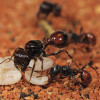The route that the deadly ebola virus uses to invade human cells, together with several potential drugs that can block it, has been discovered by Dutch and  American scientists.
American scientists.
One of a family of agents called filoviruses, ebola first surfaced in central Africa in the mid 1970s. It's a highly infectious agent that causes a severe haemorrhagic fever from which 70% of victims fail to recover. The disease is also fatal for non-human primates including chimps and gorillas and is carried by fruit bats.
Despite its relatively long history of causing fatal human infections, scientists still had no idea how the tube-like virus, which resembles a microscopic straw, actually penetrated cells, let alone how to stop it. Now two independent groups of scientists have not only tracked down the doorway that the agent uses to bust into cells, but also found two chemical compounds that can block the infectivity of the agent, offering a potential solution to the periodic outbreaks of the disease which frequently kill hundreds of people.
In the first of the pair of papers, which are published in the journal Nature, Netherlands Cancer Institute researcher Jan Carette and his colleagues track down the cellular structure targeted by ebola. The researchers used cells that they had previously infected with a form of retrovirus that inserts itself randomly into different genes, deactivating them. Nearly one million such "insertions" were mapped by the team and the cells were then challenged with a different virus carrying the outer coat of ebola.
The team were specifically looking for cells that were resistant to infection, indicating that at least one of the genes that had been deactivated by the retrovirus in the cells must be essential in allowing ebola to enter.
The team identified the Niemann-Pick C1 (NPC1) gene as one critical entry factor as well as the members of a complex called HOPS (short for homotypic fusion and vacuole protein sorting). Both are involved in enabling small membrane-bound sacs inside cells, called endosomes, to fuse with structures called lysosomes that are involved in degrading substances within cells.
Ebola, it turns out, recognises and binds to these structures, triggering the endosome to pop like a balloon. This releases the genetic material of the virus, which is then able to hijack the cell.
These findings are confirmed by the second Nature paper, by Harvard scientist James Cunningham and his colleagues, who also present the structures of two candidate drug molecules capable of blocking ebola infection in treated cells.
This group screened a range of small molecules, looking for compounds that could block the ability of a virus carrying the outer coat of ebola to enter cells treated previously with the chemicals. The first functional compound they found, called 3.0, is a novel benzylpiperazine adamantane diamide. A further 50 analogues later, they stumbled upon compound 3.47 which is similar but even more potent.
These chemicals, the team found, target the protein encoded by the NPC1 gene identified as essential by the other research group. By binding to the NPC1 gene product in the endosome, the drug molecules appear to prevent ebola from being able to attach itself, preventing it from bursting the endosome bubble and escaping into the cell.
NPC1 normally controls the uptake of cholesterol into a cell. According to Cunningham, "This is an indication of how the virus exploits normal cell processes to grow and spread," said Cunningham. "Small molecules that target NPC1 and inhibit Ebola virus infection have the potential to be developed into antiviral drugs."










Comments
Add a comment